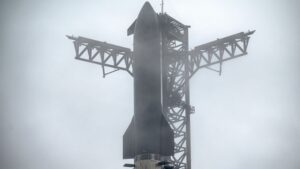SpaceX’s Upcoming Starship Launch: What You Need to Know
SpaceX is gearing up for an exciting moment in aerospace history with the launch of its seventh test flight of the Starship rocket this Thursday. This momentous event, slated to occur within a one-hour window from 5 p.m. to 6 p.m. ET at the Starbase facility in Brownsville, Texas, is more than just another launch; it represents a crucial stepping stone in the development of one of the most ambitious space vehicles ever created.
Key Objectives of the Launch
This test flight is particularly significant as SpaceX aims to advance its satellite deployment capabilities. While there won’t be any astronauts on board for this mission, the payload bay will carry 10 "Starlink simulators." These simulators are designed to emulate future Starlink satellites, providing SpaceX with the opportunity to test how effectively Starship can deploy heavier satellite loads. It’s an essential phase in the project to enhance the upcoming generation of Starlink satellites, which are expected to bring improved internet connectivity to users across the globe.
If you’re wondering about the composition of these simulators, they are likely constructed from materials that replicate the weight of the actual satellites—typical choices include metal or concrete. As this mission does not aim to achieve orbital flight, the simulators are staged to follow a trajectory similar to that of Starship and are designed to safely burn up upon re-entry.
What’s at Stake?
Assuming the launch proceeds without a hitch, Starship is expected to reach space, traverse halfway around the Earth, and splash down in the Indian Ocean roughly an hour post-launch. This flight also presents a second chance for SpaceX to execute the booster separation correctly, which will see the "Super Heavy" booster return to the company’s launch tower, a feat accomplished during the fifth flight but missed last time.
With each subsequent test, SpaceX continues to evaluate and enhance various features of the Starship system, including the crucial heat shield tiles necessary for atmospheric re-entry and trajectory management during those intense moments.
The Unmatched Power of Starship
Starship isn’t just the new kid on the block; it’s both the tallest and the most powerful rocket ever launched. Fully stacked with its Super Heavy booster, the vehicle towers at 397 feet and boasts an impressive diameter of 30 feet. As of now, SpaceX has successfully executed six spaceflight tests of the full Starship rocket system, demonstrating a steady increase in ambition and capability.
The Super Heavy booster itself measures 232 feet and features 33 Raptor engines, generating a staggering 16.7 million pounds of thrust—an astonishing figure that far surpasses that of NASA’s Space Launch System. Meanwhile, the Starship vehicle houses six Raptor engines specifically calibrated for the divergent environments of Earth’s atmosphere and the vacuum of space.
Innovations on Ship 33
The latest iteration of Starship, referred to as Ship 33, includes substantial advancements, dubbed "Block 2" by SpaceX. Notable enhancements such as redesigned flaps, an optimized propulsion system, and an upgraded flight computer speak to the company’s commitment to continuous improvement. Additionally, 30 integrated cameras will monitor various performance metrics during the flight, providing invaluable data that can be used for future missions.
Looking Ahead: Starship’s Future
SpaceX’s Starship is expected to redefine how we think about space travel, with aspirations not only to transport cargo but also to ferry humans to destinations beyond Earth, including the Moon and Mars. Notably, SpaceX has secured a multibillion-dollar contract with NASA for using Starship as part of the Artemis program, aimed at returning astronauts to the lunar surface.
At Extreme Investor Network, we keep a close eye on industries that shape our future, and space exploration is no exception. With SpaceX at the forefront of this revolution, every test flight takes us one step closer to realizing the potential of space travel, and we are excited to bring you the latest updates as this saga unfolds.
Stay tuned to our platform for exclusive insights and expert analysis on the implications of these developments in the realm of investment and technology. Your journey into the future of aerospace innovation starts here!

